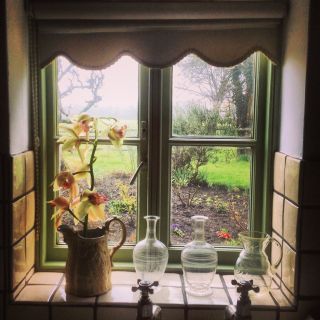Anxiety
How to Break the Habit of Being Worried and Anxious
A simple approach to overcoming fear and panic to help you gain more joy in life
Posted May 11, 2015
It's often said a weed is "a plant in the wrong place," and this morning when I was confronted by mass of little yellow flowers taking over a bed I’d painstakingly planted with purple and pink pansies, it struck me that anxiety is a bit like a weed. Anxiety is a physical and mental reaction that’s quite normal—all humans experience it—but in the hyper-anxious, it’s a reaction in the wrong place.

A weed is perfectly natural—Corydalis aurea, the yellow flower in my garden, is not made in a factory or lab, after all. Looked at objectively, Corydalis is pretty, and it’s only doing what plants do—growing and flowering and seeding itself. Yet it upsets the colour scheme of my flowerbed, so is unwelcome.
By the same token, anxiety is perfectly natural—there’s nothing wrong with being anxious per se, and at times we need anxiety to protect us from harm. The physical and mental responses associated with anxiety are designed to help us fight or flee from danger—if I was faced with a hungry lion, for instance, it would be normal and healthy to experience a rush of adrenaline and all that goes with it—faster, shallower breathing, an increase in heart rate, and perspiration.

It’s just that what happens with anxiety is that, like a weed, it can pop up when we don’t want or need it; we can end up being triggered by all sorts of events and situations which shouldn’t necessarily make us anxious, with symptoms like shortness of breath, heart palpitations and panic attacks impacting our day-to-day lives. To experience this set of reactions in a supermarket or business meeting can be very frightening.
In this respect anxiety is a ‘habit’ your body and mind has got into
To overcome anxiety, it can be very tempting to think the solution is to avoid the situations that trigger it. I’ve done this myself—ducking out of public speaking, foregoing parties, postponing plane trips—most of us can think of situations we’ve side-stepped because they scare us, and when the symptoms of excess stress and panic are so horrible, is it any wonder? In extreme situations fear of triggering an anxiety attack can lead sufferers to be so afraid they won’t leave their own homes, as members of the online anxiety support group I founded have described. Yet contrary to what outsiders might think, this isn’t because we anxious types are cowardly; it’s because we’re doing our best to protect ourselves against foreseeable distress.

It's important not to avoid experiences that make us anxious
The trouble, as I explain in my little book on the subject, is that in the long run this doesn’t help, and by avoiding people or places we’re frightened of our worlds can end up smaller and our lives less rewarding. To use an example of a journey on the underground (or subway as US readers call it); supposing as you go down the escalator you feel anxiety rising, begin to panic, and rush home. What happens is that your immediate anxiety will decrease, but also the message that avoidance helps to calm you begins to become hardwired into the brain and soon you’re panicking every time you get to the station.
The interesting thing is that if we ask ourselves what would happen if we remained in the situation we’re avoiding, whilst we’re convinced we’d pass out, throw up, collapse, have a heart attack or some such, actually, after a certain time, what really happens is that anxiety begins to decrease of its own accord. But we never get to learn this because we never face it. This is why it’s important to ‘feel the fear and do it anyway’, as Susan Jeffers said, as then we show ourselves that we can manage the situation.
Breaking the habit of anxiety isn’t something that can be done overnight or in defiance. If you challenge yourself to take that first trip on the tube/subway the very same day you have a job interview or plane to catch, you’re likely to be a state of even greater stress than usual and are more likely to fail.
Be gentle with yourself
Start small and take it slow – begin with the easiest situation and practise it
- Build up gradually – if something is too hard, look at breaking it down into smaller, more manageable chunks
- Reward your acheivements – pat yourself on the back for each small step you take
- Don’t focus on how far you’ve got to go or berate yourself for not getting there immediately
- Stop before you have reached your ultimate goal
- Repeat at least once a day if possible, each time encouraging yourself to go a little further down the pathEach day encourage yourself to go a little further down the pathSource: Sarah Rayner
So if you’re tackling travelling on the tube or subway, I’d suggest starting with a short trip of just one stop, where you’ve no deadline and can ask a friend to come with you. Then you’re more likely to succeed and be able to build up to your ultimate goal.

Don’t be impatient with yourself or your anxiety
To return to the gardening analogy, overcoming anxiety is similar to uprooting a dandelion. How tempting it is to pull off the leaves with our fingers, pat over the earth and convince ourselves we’ve weeded rather well! But really this is avoiding the problem. Dandelions are nothing if not dogged, and sure as anything the bête noir of your beds and borders will remain to haunt you. Equally, if you’re too impetuous, the chances are the root will snap off midway through your endeavours.
Far better to take your time: choose a day when the soil is damp and easier to work with, get a trowel or knife and a cushion for your knees, then dig right down and gently loosen the soil from the tap root until you slowly, very slowly, prise it from the earth.
In the space you’ve created you can plant something beautiful. Pink pansies perhaps, or maybe you prefer purple?

I hope you enjoyed this article. I’m blogging throughout this week to mark Mental Health Awareness Week. Yesterday I wrote about how the UK election results seem to have triggered anxiety in many with mental health problems. Later this week I’ll return to the subject of gardening and exploring why tending to plants and flowers is particularly therapeutic. I hope you enjoy my writing and find my suggestions helpful.





